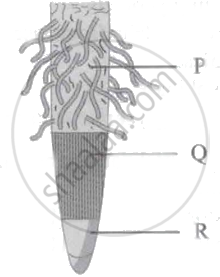Advertisements
Advertisements
प्रश्न
Describe the structure of phloem.
उत्तर
Phloem is made up of four types of cells :
1) Sieve tubes: These are tubular channels formed of elongated living cells, arranged in vertical rows.The transverse end walls are perforated with a number of pores (sieve plates). The cytoplasm of one element is continuous with the other through these pores. Nuclei are absent in sieve tubes.
2) Companion cells: These are small cells associated with sieve tubes, with dense cytoplasm and a large elongated nucleus. They remain connected to the sieve tubes by pores
3) Phloem parenchyma: These are simple delicate cells containing starch, tannin and crystals. These cells perform the function of storage and translocation of food substances.
4) Basil fibres: These are sclerenchymatous cells occurring in the phloem. They are composed of dead cells and function as storage tissue.
APPEARS IN
संबंधित प्रश्न
What is 'tissue culture'?
Mention two advantages of micro propagation.
In the following questions/statements has four suggested answers. Rewrite the correct answer
Roots and shoots lengthen through the activity of:
(A) Apical meristem
(B) Vascular Cambium
(C) Lateral meristem
(D) Cork Cambium
Explain the transpiration pull theory for an ascent of sap
Why are xylem and phloem classified as complex tissues?
Name the technique and the property of plant cells that can help to grow somaclones of certain desired varieties of apple. Explain how somaclones of apple can be obtained in the lab so as to get the desired variety on a large scale.
Identify labels P, Q, R in the given figure of root showing different regions.

In virus-infected plants the meristematic tissues in both apical and axillary buds are free of virus because ______.
Would it be wrong to call plants obtained through micro-propagation as ‘clones’? Comment.
Write a short note on suspension culture.
